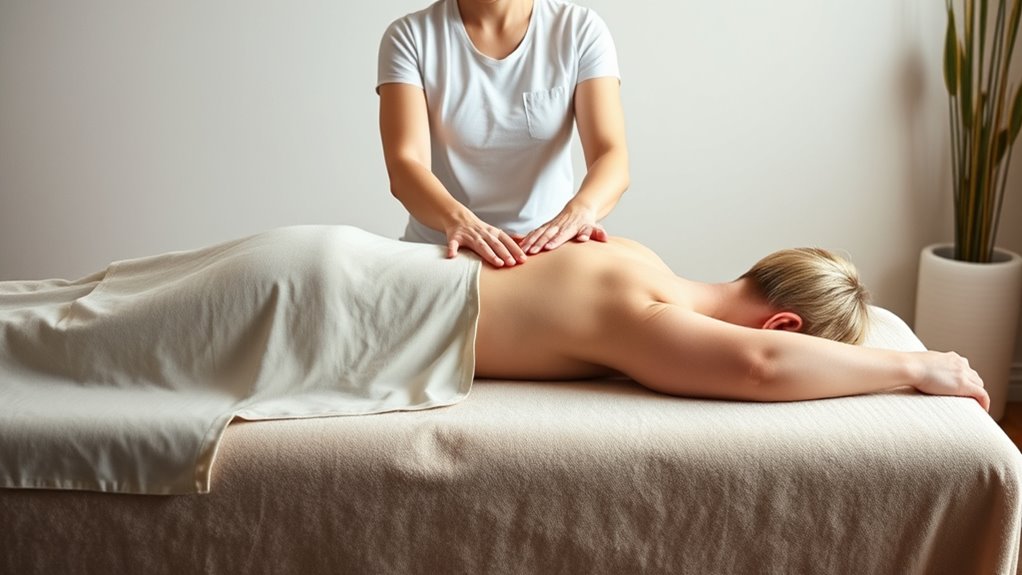To improve your posture during sessions, keep your feet flat and grounded, and maintain a neutral spine by engaging your core. Adjust your chair and desk height so your elbows are close to 90 degrees, and use supportive cushions if needed. Take regular micro-breaks, stretch, and check your posture every 20-30 minutes. Paying attention to these details will keep you comfortable and focused—you’ll discover even more tips as you explore further.
Key Takeaways
- Maintain feet flat and shoulder-width apart for stability and even weight distribution during sessions.
- Keep a neutral spine by engaging core muscles and aligning ears over shoulders.
- Use ergonomic accessories like cushions, footrests, and lumbar supports to enhance comfort.
- Take regular micro-breaks to stretch, move, and check your posture to prevent stiffness and strain.
- Adjust workspace setup, including monitor height and chair, for optimal support and long-term ergonomic health.
Keep Your Feet Flat and Grounded

To maintain proper posture during your sessions, it’s important to keep your feet flat and grounded. Your foot placement directly influences your balance and stability, helping you stay centered and avoid unnecessary strain. Ensure your feet are shoulder-width apart for ideal weight distribution, which keeps your body aligned. When your feet are flat on the ground, it promotes better support and reduces tension in your lower back and legs. Avoid lifting your heels or shifting weight unevenly, as this can cause discomfort and poor posture. Focus on evenly distributing your weight across both feet, which encourages a stable stance and helps you maintain focus. Proper foot placement not only enhances comfort but also supports your overall posture during extended sessions. Additionally, being mindful of your foot positioning can help prevent fatigue and improve your overall ergonomic setup.
Maintain Neutral Spine Alignment

Maintaining a neutral spine alignment is essential for preventing strain and promoting good posture during your sessions. Focus on engaging your core muscles to support your back, keeping your spine in a natural, straight position. Use breathing techniques to stay relaxed and avoid tension buildup. Proper alignment reduces discomfort and enhances focus. To help, refer to this quick guide:
| Position | Action | Tips |
|---|---|---|
| Sitting | Keep ears over shoulders | Breathe deeply to stay relaxed |
| Standing | Distribute weight evenly | Engage core for stability |
| Lying Down | Maintain natural curve | Use gentle breathing techniques |
Staying conscious of your spine’s position ensures better posture and session quality.
Adjust Your Chair and Desk Height Properly

Ensuring your chair and desk are at the correct height is essential for maintaining good posture during your sessions. Proper chair height allows your feet to rest flat on the floor, with knees at a 90-degree angle. Desk alignment should keep your elbows close to your body, forming roughly a 90-degree angle when typing or writing. Additionally, regularly assessing your workspace setup can help prevent strain and ensure continued comfort during long sessions.
Use Supportive Cushions When Needed

Proper cushion placement can make a big difference in supporting your lower back and hips. Choose a material that feels comfortable and provides enough firmness to maintain good posture. Experiment with different positions and materials to find what keeps you most supported during sessions. Incorporating awareness of your relationship dynamics can also help you select the most effective support strategies.
Optimal Cushion Placement
Using supportive cushions can considerably improve your posture during sessions by providing the necessary stability and comfort. Proper cushion placement guarantees your body stays aligned and reduces strain. Position your ergonomic footrests so your feet rest flat, supporting your lower back and promoting circulation. Adjust your lumbar support placement to maintain the natural curve of your spine, preventing slouching. Place cushions behind your lower back for added lumbar support, or under your hips if needed. Ensure your cushions are snug but not tight, avoiding unnecessary pressure points. Visualize your workspace with a firm cushion supporting your lumbar region, your feet firmly on ergonomic footrests, and your hips slightly elevated. This setup encourages ideal posture, reducing fatigue and discomfort during long sessions. Incorporating posture awareness techniques can further enhance your ergonomic setup and prevent strain.
Choosing the Right Material
Selecting the right material for your cushions can make a significant difference in maintaining comfort and support during long sessions. Opt for ergonomic tools like memory foam or gel-filled cushions that conform to your body, providing better pressure distribution. These materials promote proper posture awareness, helping you avoid strain and discomfort over extended periods. Avoid hard or slippery surfaces that can cause slipping or uneven support, leading to poor posture. Instead, choose cushions with breathable covers to prevent overheating and sweating, which can distract you from maintaining focus. The right material not only enhances your comfort but also encourages consistent ergonomic habits, reducing fatigue. Additionally, selecting cushions made from high-quality materials ensures durability and long-term support, making your sessions more comfortable and sustainable. When selecting cushions, consider both firmness and texture to ensure they support your body’s natural alignment without adding unnecessary pressure.
Practice Regular Micro-Breaks and Movement

To maintain good posture during long sessions, incorporating regular micro-breaks and movement into your routine is essential. These short pauses help prevent stiffness and reduce strain. During stretch breaks, gently stretch your neck, shoulders, and back to keep muscles relaxed. Eye exercises, like focusing on distant objects, can alleviate eye fatigue from screen time. Moving your legs and shifting your position also boost circulation and energy levels. Additionally, creating a personalized work environment that supports comfort can enhance your overall posture and productivity. Consider these actions:
- Stand up and stretch your arms and back
- Perform eye exercises by looking away from your screen
- Walk around briefly to stimulate circulation
- Change your sitting posture slightly to avoid stiffness
Integrating these small movements keeps your body engaged and minimizes discomfort during lengthy sessions.
Position Your Client for Optimal Ergonomics

Properly positioning your client is key to maintaining their comfort and preventing strain during sessions. Use ergonomic accessories like adjustable cushions, lumbar supports, or footrests to optimize client positioning. These tools help support natural posture and reduce pressure on joints and muscles. Guarantee their seat height allows their feet to rest flat on the ground and their hips and knees to form roughly 90-degree angles. Keep their spine aligned, avoiding slouching or overreaching. Adjust the head and arm positions so they remain relaxed and supported. Remember, effective client positioning isn’t just about comfort—it’s about creating an ergonomic setup that minimizes fatigue and promotes proper biomechanics throughout the session. Proper positioning sets the foundation for a productive, strain-free experience for both you and your client. Proper ergonomics can further enhance comfort and support during sessions.
Be Mindful of Your Arm and Wrist Angles

Being mindful of your arm and wrist angles is essential to prevent strain and improve your session efficiency. Proper wrist positioning and arm ergonomics ensure comfort and reduce injury risk. Keep your wrists in a neutral position, avoiding excessive bending or twisting. Maintain a relaxed grip, avoiding unnecessary tension in your forearm. Focus on aligning your elbows and wrists to minimize awkward angles. Paying attention to these details helps you stay comfortable longer and perform better during your session, preventing fatigue and discomfort. Additionally, being aware of retail hours can help you plan your sessions around store availability and avoid unnecessary stress.
Incorporate Posture Checks Into Your Routine

Incorporating posture checks into your routine guarantees you stay mindful of your alignment throughout each session. Regularly pausing to evaluate your setup helps prevent strain and promotes comfort. Use ergonomic footrests to keep your feet supported, ensuring proper leg alignment. Check your ergonomic mouse placement to avoid reaching or twisting your wrist. Incorporate quick posture assessments every 20-30 minutes, focusing on your back, shoulders, and neck. Consider this simple table as a reminder:
| Posture Check | Adjustment Needed | Tools to Help |
|---|---|---|
| Feet on ergonomic footrest | Keep feet flat and supported | Footrest, adjustable height |
| Mouse position | Keep close, wrist straight | Ergonomic mouse placement |
| Sitting upright | Relax shoulders, align spine | Lumbar support, chair height |
Staying informed about ergonomic accessories can further enhance your comfort and prevent strain during long sessions. Stay consistent—you’ll notice the difference.
Frequently Asked Questions
How Can I Correct My Posture if I Feel Discomfort During Sessions?
If you feel discomfort during sessions, start by making ergonomic adjustments to your workspace, like adjusting your chair or monitor height. Take regular breaks to stretch and promote muscle relaxation, preventing stiffness. Focus on maintaining a neutral spine and engaging your core muscles. Listening to your body helps you identify what needs change, so you can improve your posture gradually and comfortably, reducing discomfort and enhancing your overall session experience.
Are There Specific Stretches to Improve Posture for Prolonged Sitting?
Yes, incorporating ergonomic stretches and posture exercises helps improve your posture during prolonged sitting. Try neck stretches, shoulder rolls, and chest openers regularly to counteract stiffness. Incorporate lumbar twists and seated cat-cows to strengthen your back muscles. Keep your shoulders relaxed, and avoid slouching. These targeted stretches and exercises promote better alignment, reduce discomfort, and support long-term posture health during extended sitting periods.
What Are Signs of Poor Ergonomics That I Should Watch For?
Like a modern-day detective, you should watch for ergonomic hazards that signal poor ergonomics. Signs include persistent neck or back pain, frequent headaches, or tingling in your arms. If you notice discomfort despite adjustments, it’s time to prioritize posture monitoring. Ignoring these signs can lead to long-term issues. Stay vigilant, listen to your body, and regularly check your workspace to prevent strain and maintain ideal comfort.
How Often Should I Reassess My Posture During a Session?
You should reassess your posture every 15 to 30 minutes during a session. This helps maintain posture awareness and catch any slouching or misalignment early. Set a reminder or use session intervals to check in with yourself, ensuring your body stays properly aligned. Regularly reassessing prevents discomfort and promotes better ergonomics, keeping you comfortable and focused throughout your session.
Can Posture Tips Help Prevent Long-Term Musculoskeletal Issues?
Yes, posture tips can help prevent long-term musculoskeletal issues. By using ergonomic accessories like adjustable chairs and desk setups, you reduce strain and promote proper alignment. Incorporate core strengthening exercises into your routine to support your spine and improve posture naturally. Regularly applying these tips during sessions helps you maintain healthy posture habits, decreasing the risk of chronic problems and ensuring comfort over time.
Conclusion
Stay mindful of your posture, and you’ll unlock a world of comfort and confidence. But remember, even the tiniest misalignment can quietly creep in, waiting to disrupt your flow. Will you catch it before it takes hold? Keep these tips close, stay vigilant, and imagine yourself confidently maintaining perfect alignment. The secret to enduring sessions isn’t just in the tips—it’s in your awareness. Are you ready to discover what’s next?









